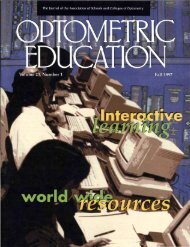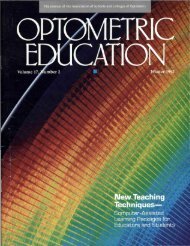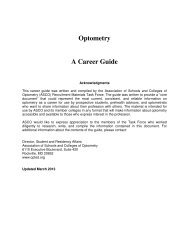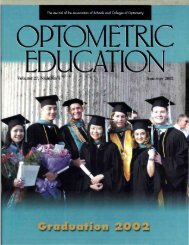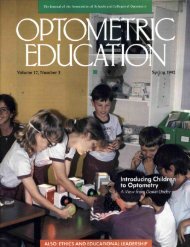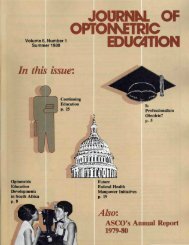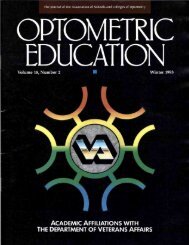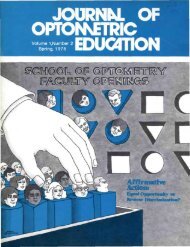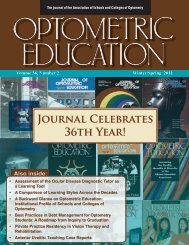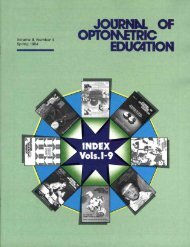JOURNN. OF - Association of Schools and Colleges of Optometry
JOURNN. OF - Association of Schools and Colleges of Optometry
JOURNN. OF - Association of Schools and Colleges of Optometry
Create successful ePaper yourself
Turn your PDF publications into a flip-book with our unique Google optimized e-Paper software.
Parsons 48 reported in 1976 on a formula<br />
used at Golden West College. It<br />
uses five different variables thought to<br />
reflect the minimum number <strong>of</strong> principal<br />
parameters necessary to measure a<br />
teaching load:<br />
IH . NP . SE . OA<br />
A "*" B ' C D<br />
PA<br />
E<br />
x 100 = total teaching load in percent<br />
IH is weekly instruction hours; NP is<br />
different class preparations; SE is weekly-student<br />
contact hours (WSCH); OA<br />
is out-<strong>of</strong>-class assignments in hours/<br />
week; <strong>and</strong> PA is parapr<strong>of</strong>essional assistance<br />
provided, (Expressed as 0.08 x<br />
HRS or 2% per hour <strong>of</strong> instruction work<br />
credit subtracted from the total teaching<br />
load.)<br />
A is the st<strong>and</strong>ard teaching load <strong>of</strong> 15<br />
hours/week; B is the st<strong>and</strong>ard teaching<br />
load reference <strong>of</strong> five different class<br />
preparations/week; C is the st<strong>and</strong>ard<br />
teaching load reference <strong>of</strong> 500<br />
WSCH.* (Found by multiplying the<br />
class enrollment by the number <strong>of</strong><br />
weekly class hours <strong>and</strong> expressed as the<br />
sum <strong>of</strong> all classes; D is the st<strong>and</strong>ard<br />
teaching load reference <strong>of</strong> five hours/<br />
week <strong>of</strong> out-<strong>of</strong>-class duties (excludes <strong>of</strong>fice<br />
hours for student advising); <strong>and</strong> E is<br />
one in the equation.<br />
Table 7 pictures five sample faculty<br />
with this system applied.<br />
Other Approaches<br />
Eagleton 49 reports on a workload formula<br />
that was developed by faculty at<br />
the Pennsylvania State University. Their<br />
formula blocks workload into teaching<br />
<strong>and</strong> advising; research <strong>and</strong> graduate<br />
study; service to university, pr<strong>of</strong>ession<br />
<strong>and</strong> public; <strong>and</strong> scholarship <strong>and</strong> pr<strong>of</strong>essional<br />
development, using weighted<br />
point values that indicate a total load for<br />
an entire semester.<br />
Faculty workload has been ignored,<br />
in the main, by educators in the health<br />
pr<strong>of</strong>essions. Holliman, 13 a nursing educator,<br />
does discuss a unique but<br />
straightforward approach to analyzing<br />
faculty workload. The end in view was<br />
to determine the need for additional<br />
faculty. Step one in this system is to<br />
establish time norms for an academic<br />
year.<br />
Non-productive time,<br />
in days/year/person<br />
20 vacation<br />
5 sick leave<br />
104 weekends<br />
14 holidays<br />
143 total rounded to 140<br />
days/year/person<br />
Productive time,<br />
in days/year/person<br />
365-140 = 225 productive days<br />
Step two is to calculate an individual<br />
teacher workload pr<strong>of</strong>ile. This is accomplished<br />
by subtracting the time commitments<br />
per element within the assigned<br />
load from the productive days. For example,<br />
5 days for continuing education,<br />
9 days for committee work (6 hours/<br />
month), 5 days for annual faculty meeting<br />
<strong>and</strong> curriculum reviews. This gives a<br />
balance <strong>of</strong> days to be assigned to class/<br />
clinical/preparation time. The ratio for<br />
preparation is class 2:1 <strong>and</strong> clinical 1:3.<br />
A course that would meet for 23 class<br />
hours would be computed as consuming<br />
a faculty member's time as follows:<br />
23 hours class -I- 46 hours preparation<br />
(23 x 2) for a total <strong>of</strong> 69. All such teaching<br />
time computations are totaled, converted<br />
to days by dividing by 8, <strong>and</strong><br />
then subtracted from the productive<br />
time available. Load balances are thus<br />
achieved by juggling the assignments<br />
given <strong>and</strong> the productive days available,<br />
both expressed in days/year.<br />
Still another approach to faculty load<br />
assignment expresses the various activities<br />
as a percent <strong>of</strong> total effort. While<br />
some hourly assumptions per activity<br />
must be made to arrive at assigned percent<br />
<strong>of</strong> effort, this system has the advantage<br />
<strong>of</strong> elasticity for the work-habit<br />
variations that tend to exist within any<br />
group <strong>of</strong> faculty. This particular<br />
methodology is currently employed<br />
within the College <strong>of</strong> <strong>Optometry</strong>, Pacific<br />
University. Not unlike the productive<br />
time approach <strong>of</strong> Holliman, 13 the first<br />
step is to compute the gross number <strong>of</strong><br />
productive days available within the<br />
faculty contract period taking into account<br />
days dedicated to all university<br />
<strong>and</strong> college functions <strong>and</strong> holidays. Net<br />
productive days are then converted to<br />
net productive hours per contract<br />
period per faculty member. This number<br />
becomes the denominator constant<br />
for computing percent <strong>of</strong> effort per assigned<br />
activity. Teaching activities are<br />
determined using the following subformula:<br />
Total time for lecture/seminar classes<br />
= contact hours x 3 (allows 2 for 1<br />
preparation time); total time for laboratory<br />
classes = contact hours x 1.5<br />
(allows V2 for 1 preparation time); total<br />
time for clinical supervision = contact<br />
hours; <strong>and</strong> total time for thesis supervision<br />
= 2 hours/week <strong>of</strong> thesis course<br />
enrollment.<br />
•Reference st<strong>and</strong>ard obtained by using a typical<br />
class enrollment figure <strong>of</strong> no less than 32 nor more<br />
than 35 students enrolled as a nominal value.<br />
WSCH is weekly student contact hours.<br />
TABLE 7<br />
An Example <strong>of</strong> the Work Load <strong>of</strong> Five Faculty Using System Employed by Golden West College<br />
(Health Sciences)<br />
Faculty<br />
Member<br />
Instruction<br />
Hours/Week<br />
IH<br />
15<br />
Number <strong>of</strong><br />
Preparations<br />
NP<br />
5<br />
Weekly<br />
Student<br />
Contact Hrs.<br />
WSCH<br />
500<br />
Outside<br />
Assignments<br />
Hrs./Week<br />
5<br />
Parapr<strong>of</strong>essional<br />
Assistance<br />
Total Load<br />
Factor in<br />
Percent<br />
A<br />
17.25<br />
1.15<br />
4.5<br />
0.90<br />
545<br />
1.09<br />
4<br />
0.80<br />
0<br />
98.50<br />
B<br />
17.25<br />
1.15<br />
3.5<br />
0.70<br />
672<br />
1.34<br />
7.5<br />
1.50<br />
-0.64<br />
101.25<br />
C<br />
8.88<br />
0.59<br />
1.67<br />
0.33<br />
601<br />
1.20<br />
8.0<br />
1.60<br />
0<br />
93.05<br />
D<br />
13.0<br />
0.87<br />
3.5<br />
0.70<br />
428<br />
0.86<br />
12.25<br />
2.45<br />
0.52<br />
109.00<br />
E<br />
21.25<br />
1.42<br />
1.75<br />
0.35<br />
772<br />
1.54<br />
4.5<br />
0.90<br />
-0.10<br />
102.85<br />
20 Journal <strong>of</strong> Optometric Education



